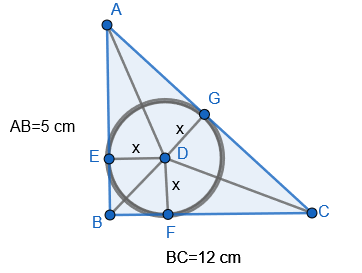
In a right angled triangle ABC, right-angled at B, \[BC=12\,cm\] and \[AB=5\,cm\]. The radius of the circle inscribed in the triangle (in cm) is
(a) 4
(b) 3
(c) 2
(d) 1
Answer
598.5k+ views
Hint: First we will draw the figure from the given details in the question and then using Pythagoras theorem we will find the length of side AC. Then we will calculate the area of triangle ABC and then we will equate it with the summation of areas of small triangles inside the figure.
Complete step-by-step solution -
Drawing the figure from the given details in the question,

As the triangle is right angled triangle, so from Pythagoras theorem, \[\text{AC=}\sqrt{\text{A}{{\text{B}}^{\text{2}}}\text{+B}{{\text{C}}^{\text{2}}}}........(1)\]. Now substituting the values of AB and BC in equation (1) we get,
\[\text{AC=}\sqrt{{{5}^{\text{2}}}\text{+1}{{\text{2}}^{\text{2}}}}=\sqrt{25+144}=\sqrt{169}=13\,cm\]
Now let the radius of the circle inscribed in the triangle be x.
So from the figure we can see that the area of triangle ABC(A) \[=\dfrac{1}{2}\times \text{AB }\!\!\times\!\!\text{ BC}......(2)\] (
Putting the values of AB and BC in equation (2) we get,
\[\text{A=}\dfrac{\text{1}}{\text{2}}\text{ }\!\!\times\!\!\text{ 5}\times 12.=30\,c{{m}^{2}}.....(3)\]
Now the area of ADB \[=\dfrac{1}{2}\times ED\times AB......(4)\]
Now putting the value of ED and AB in equation (4) we get,
\[\Rightarrow \dfrac{1}{2}\times x\times 5=\dfrac{5x}{2}......(5)\]
Now the area of BDC \[=\dfrac{1}{2}\times DF\times BC......(6)\]
Now putting the value of DF and BC in equation (6) we get,
\[\Rightarrow \dfrac{1}{2}\times x\times 12=6x......(7)\]
Now the area of ADC \[=\dfrac{1}{2}\times DG\times AC......(8)\]
Now putting the value of DG and AC in equation (8) we get,
\[\Rightarrow \dfrac{1}{2}\times x\times 13=\dfrac{13x}{2}......(9)\]
From the figure we know that the summation of area of ADB, area of BDC and area of ADC is equal to area of ABC. So using this information we equate equation (3) with the summation of equation (5), equation (7) and equation (9) we get.
\[\Rightarrow 30\,=\dfrac{5x}{2}+6x+\dfrac{13x}{2}.....(10)\]
Now taking the LCM and rearranging in equation (10) we get,
\[\begin{align}
& \Rightarrow 30\,=\dfrac{5x+12x+13x}{2} \\
& \Rightarrow \dfrac{30x}{2}=30..........(11) \\
\end{align}\]
Now solving for x in equation (11) we get,
\[\Rightarrow x=2\,cm\]
Hence the correct answer is option (c).
Note: Here we have to remember the formula of Pythagoras theorem and formula of area of triangle. Area of triangle \[=\dfrac{1}{2}\times base\times height\]. We in a hurry can make a mistake in solving equation (10) so we need to be careful while doing this step.
Complete step-by-step solution -
Drawing the figure from the given details in the question,

As the triangle is right angled triangle, so from Pythagoras theorem, \[\text{AC=}\sqrt{\text{A}{{\text{B}}^{\text{2}}}\text{+B}{{\text{C}}^{\text{2}}}}........(1)\]. Now substituting the values of AB and BC in equation (1) we get,
\[\text{AC=}\sqrt{{{5}^{\text{2}}}\text{+1}{{\text{2}}^{\text{2}}}}=\sqrt{25+144}=\sqrt{169}=13\,cm\]
Now let the radius of the circle inscribed in the triangle be x.
So from the figure we can see that the area of triangle ABC(A) \[=\dfrac{1}{2}\times \text{AB }\!\!\times\!\!\text{ BC}......(2)\] (
Putting the values of AB and BC in equation (2) we get,
\[\text{A=}\dfrac{\text{1}}{\text{2}}\text{ }\!\!\times\!\!\text{ 5}\times 12.=30\,c{{m}^{2}}.....(3)\]
Now the area of ADB \[=\dfrac{1}{2}\times ED\times AB......(4)\]
Now putting the value of ED and AB in equation (4) we get,
\[\Rightarrow \dfrac{1}{2}\times x\times 5=\dfrac{5x}{2}......(5)\]
Now the area of BDC \[=\dfrac{1}{2}\times DF\times BC......(6)\]
Now putting the value of DF and BC in equation (6) we get,
\[\Rightarrow \dfrac{1}{2}\times x\times 12=6x......(7)\]
Now the area of ADC \[=\dfrac{1}{2}\times DG\times AC......(8)\]
Now putting the value of DG and AC in equation (8) we get,
\[\Rightarrow \dfrac{1}{2}\times x\times 13=\dfrac{13x}{2}......(9)\]
From the figure we know that the summation of area of ADB, area of BDC and area of ADC is equal to area of ABC. So using this information we equate equation (3) with the summation of equation (5), equation (7) and equation (9) we get.
\[\Rightarrow 30\,=\dfrac{5x}{2}+6x+\dfrac{13x}{2}.....(10)\]
Now taking the LCM and rearranging in equation (10) we get,
\[\begin{align}
& \Rightarrow 30\,=\dfrac{5x+12x+13x}{2} \\
& \Rightarrow \dfrac{30x}{2}=30..........(11) \\
\end{align}\]
Now solving for x in equation (11) we get,
\[\Rightarrow x=2\,cm\]
Hence the correct answer is option (c).
Note: Here we have to remember the formula of Pythagoras theorem and formula of area of triangle. Area of triangle \[=\dfrac{1}{2}\times base\times height\]. We in a hurry can make a mistake in solving equation (10) so we need to be careful while doing this step.
Recently Updated Pages
Two men on either side of the cliff 90m height observe class 10 maths CBSE

What happens to glucose which enters nephron along class 10 biology CBSE

Cutting of the Chinese melon means A The business and class 10 social science CBSE

Write a dialogue with at least ten utterances between class 10 english CBSE

Show an aquatic food chain using the following organisms class 10 biology CBSE

A circle is inscribed in an equilateral triangle and class 10 maths CBSE

Trending doubts
Why is there a time difference of about 5 hours between class 10 social science CBSE

Write a letter to the principal requesting him to grant class 10 english CBSE

What is the median of the first 10 natural numbers class 10 maths CBSE

The Equation xxx + 2 is Satisfied when x is Equal to Class 10 Maths

Which of the following does not have a fundamental class 10 physics CBSE

State and prove converse of BPT Basic Proportionality class 10 maths CBSE




